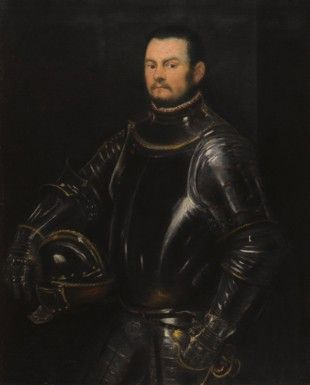Jacopo Robusti, called Jacopo Tintoretto, Portrait of a young bearded man, three-quarter-length, wearing ar
Jacopo Robusti, called Jacopo Tintoretto (Venice 1518 – 1594), Portrait of a young bearded man, three-quarter-length, wearing armour. Photo Sotheby's
oil on canvas; 122 by 99.9 cm.; 48 by 39 1/4 in. Estimation 80,000-120,000 GBP. Unsold
EXHIBITED: London, Colnaghi, In the company of Old Masters, 11 October - 4 November 2005.
LITTERATURE: In the company of Old Masters, exhibition catalogue, London, Colnaghi,11 October - 4 November 2005, reproduced in colour
NOTE DE CATALOGUE: By the early 1550s Tintoretto had refined his vocabulary as a portraitist and in 1551 he had replaced Titian as official portraitist to the Venetian Republic. His social connections, the quality of his work and above all his speed of execution secured him this position. This present portrait most likely dates from this decade, which was without doubt the most important in terms of his development as a portrait painter. The increasingly large number of official commissions finally culminated in 1559 with his portrait of the Doge Giuliano Priuli. Another comparable portraits from this period include the similarly martial portrait of an anonymous thirty-year old Commander in the Kunsthistorisches Museum in Vienna, or the Benedetto Soranzo of circa 1557 at Harewood House.1
The deliberately restrained colour palette, the sympathetic and assured handling of the face, contrasted with the bolder and more rapid brushtrokes delineating the armour and its sheen are typical of Tintoretto's mature style. The abiding influence remains that of Titian, and in works such as this Tintoretto must surely have been aware of the latter's portraits of the Emperor Charles V (now lost) , Francesco Maria della Rovere (1536, Uffizi) or his Alfonso d'Avalos of 1533 now in the Getty.2
Although the mounting pressures of commissions would inevitably diminish his own participation in many later works, Tintoretto's abilities as a portraitist were greatly admired by his contemporaries. Cristoforo Sorte, writing in his Ossservationi nella pittura in 1580, praised his 'perfettissimo giudicio nei ritratti' (most perfect judgement in portraits) and in his Trattato dell'arte della pittura of 1584 Gian Paolo Lomazzo refers to him as 'ritrattista d'eterna fama' (a portraitist of eternal fame).
We are grateful to both Frederick Ilchman and Dr. Robert Echols for endorsing the attribution to Jacopo Tintoretto, with perhaps the exception of the armour, on the basis of a photograph, and for suggesting a date of execution in the 1550s.
1. Both exhibited, Vienna, Kunsthistorisches Museum, amd Venice, Galleria dell'Accademia, Jacopo Tintoretto. Portraits, 1994, cat. nos. 17 and 18.
2. For which see H. Wethey, The paintings of Titian, vol. II, The Portraits, London 1971, pp. 78-9, 135-6, 191-2, cat. nos 9, 89 and L3, reproduced figs. 49, 56 and 67.
Sotheby's. Old Master & British Paintings Evening Sale. Londres | 04 juil. 2012 www.sothebys.com

/https%3A%2F%2Fprofilepics.canalblog.com%2Fprofilepics%2F1%2F0%2F100183.jpg)
/https%3A%2F%2Fstorage.canalblog.com%2F03%2F02%2F119589%2F96711876_o.jpg)
/https%3A%2F%2Fstorage.canalblog.com%2F11%2F31%2F119589%2F94773502_o.jpg)
/https%3A%2F%2Fstorage.canalblog.com%2F20%2F83%2F119589%2F94772815_o.jpg)
/https%3A%2F%2Fstorage.canalblog.com%2F26%2F72%2F119589%2F75604929_o.jpg)
/https%3A%2F%2Fstorage.canalblog.com%2F59%2F60%2F119589%2F26458628_o.jpg)



/http%3A%2F%2Fstorage.canalblog.com%2F84%2F73%2F119589%2F128782095_o.jpeg)
/http%3A%2F%2Fstorage.canalblog.com%2F51%2F54%2F119589%2F121075251_o.jpg)
/http%3A%2F%2Fstorage.canalblog.com%2F02%2F29%2F119589%2F117624003_o.jpg)
/http%3A%2F%2Fstorage.canalblog.com%2F68%2F58%2F119589%2F111917181_o.jpg)